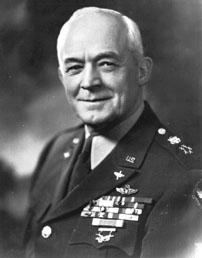(1886–1950) commanding general of U.S. Army Air Forces
Born in the Philadelphia suburb of Gladwyne, Pennsylvania, Henry “Hap” Arnold attended West Point and graduated in 1907 with a commission as second lieutenant in the infantry. He served in the Philippines during 1907–09, but soon became passionately interested in flying. Obtaining a transfer to the aeronautical section of the Signal Corps in April 1911, he received his flight instruction that June from none other than the Wright brothers, who were under U.S. Army contract.
Arnold proved to be a born aviator and in October 1912 won the Mackay Trophy for successfully completing the first reconnaissance flight in a heavier-than-air craft. Arnold hoped that this success would help to motivate U.S. Army interest in military aviation, but the tradition-bound army brass was unmoved, and Arnold was sent back to the infantry in April 1913. Three years later, he returned to the air service, where, promoted to captain in May 1916, he supervised the army’s aviation training schools as the United States entered World War I in 1917. He supervised air training throughout America’s involvement in the war, from May 1917 through 1919.
The postwar U.S. military was subject to massive demobilization and drastic reductions in funding. Nevertheless, Arnold continued to work toward developing the Army Air Corps. He was sent to the army’s Command and General Staff School, from which he graduated in 1929 with the rank of lieutenant colonel and in 1931 was given command of the 1st Bomb Wing and the 1st Pursuit Wing at March Field, California. During July and August 1934, he led a flight of ten B-10 bombers on a round trip from Washington, D.C., to Fairbanks, Alaska, winning a second Mackay Trophy for his demonstration of the endurance of the modern bomber.
Promoted to brigadier general, Arnold took command of 1st Wing, GHQ Air Force in February 1935 and was named assistant chief of staff of the Air Corps in December of that year. With the death of General Oscar Westover in September 1938, Arnold was promoted to the temporary rank of major general and named chief of staff of the Air Corps. He used his new authority to initiate programs to improve the combat readiness of the Air Corps, but he was severely hampered by a shortage of funds and a lingering reluctance on the part of military planners to develop a fully effective air arm. Nevertheless, his advocacy of air power did not go unrecognized. He was named acting deputy chief of staff of the army for air matters in October 1940 and chief of the Army Air Corps after it had been renamed the U.S. Army Air Forces in June 1941. Following this new appointment came a promotion to temporary lieutenant general, which was conferred shortly after the bombing of Pearl Harbor and America’s entry into World War II.
In March 1942, Arnold was named commanding general of Army Air Forces and the following year was promoted to the temporary rank of general. Arnold now served on the U.S. Joint Chiefs of Staff, which put him in a key position for the shaping of Allied strategy in the European as well as Pacific theaters. Arnold not only advocated and supervised the strategic bombing of Germany, he created the Twentieth Air Force in April 1944 to carry out the strategic bombing of Japan. Significantly, this unit reported directly to his command as a representative of the Joint Chiefs. This was a bold and savvy step toward the eventual (postwar) creation of a United States Air Force independent of the U.S. Army.
In December 1944, with generals Dwight D. Eisenhower, Douglas MacArthur, and George Catlett Marshall, Arnold was elevated to the rank of general of the army—five-star general. He continued to command the Army Air Forces through the end of the war, retiring in March 1946. On September 18, 1947, thanks in large part to the foundation he had laid, the Army Air Forces became an independent service, and in May 1949, in recognition of the role he played as father of the U.S. Air Force, Arnold, although retired, was named first general of the air force. He died the following year on his ranch in Sonoma, California.
Further reading: Coffey, Thomas M. Hap: The Story of the U.S. Air Force and the Man Who Built It, General Henry H. “Hap” Arnold. New York: Penguin, 1982; Daso, Dik Alan. Hap Arnold and the Evolution of American Airpower. Washington, D.C.: Smithsonian, 2001.
